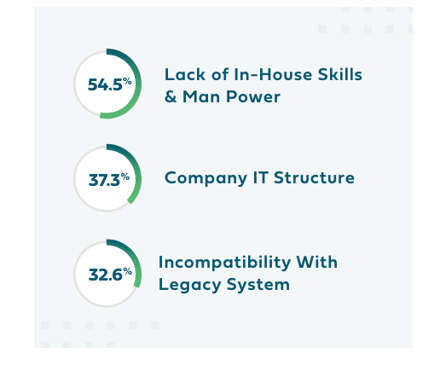What’s the biggest roadblock organizations face when adopting Kubernetes?
 If your first answer was concerning over cost, this report from The New Stack may surprise you. Citing a recent survey of 1,200 technology leaders, the article highlights that the top three issues organizations face are:
If your first answer was concerning over cost, this report from The New Stack may surprise you. Citing a recent survey of 1,200 technology leaders, the article highlights that the top three issues organizations face are:
- Lack of in-house skills
- Company IT structure
- Incompatibility with legacy systems
For those of us who have been knee-deep in Kubernetes since its inception, these results make sense. The shift from traditional waterfall development to containers and Kubernetes is a major sea change, one that affects not just workflows but entire organizational structures. And unless you have the skills readily available to guide that shift—or invest in bringing those skills onboard—just knowing where to begin with your transformation can be hard to nail down.
 Compounding this confusion are the many different distributions of Kubernetes, whether it’s open-source or via products such as SUSE Rancher or Red Hat OpenShift—each of which requires its own skillset.
Compounding this confusion are the many different distributions of Kubernetes, whether it’s open-source or via products such as SUSE Rancher or Red Hat OpenShift—each of which requires its own skillset.
None of this means concerns over cost don’t play a part in the struggle to adopt Kubernetes and containers, just that those concerns aren’t top of mind. In fact, in that same survey reported on by The New Stack, just 17% of respondents felt that cost overruns were their biggest issue, compared to nearly 55% who cited lack of skills.
Bridging the talent gap
 While it can be tempting to simply throw dollars at bringing in talent, especially if your organization is committed to adopting containers and Kubernetes, doing so nearly always creates major headaches.
While it can be tempting to simply throw dollars at bringing in talent, especially if your organization is committed to adopting containers and Kubernetes, doing so nearly always creates major headaches.
For one, in order to fully get up to speed on the tools, you need more than just one Yoda-like figure to guide your adoption. Scaling, complex requirements like stateful applications, provisioning, networking connectivity—each require experience to get right. And, while individuals with each of these skill sets exist, they’re often prohibitively expensive.
Another common issue is trying to sprint before you can walk. As with any new technology, adopting containers and Kubernetes is a process, one that involves nearly every segment of your operations.
Because of this, the right approach—both from a financial and success standpoint—is to start small with a pilot project, then build upon that project as you go. That way, whatever talent you have brought in to help guide the process will be able to actually bring your development and IT teams through a project from inception to completion.
Another route you can take is to partner with a third party that specializes in guiding you through the adoption and implementation process. This has the added benefit of not requiring an investment in bringing on talent for the long haul, which often makes it a much more cost-effective way to train your teams.
Regardless of which route you choose, the benefits of adopting containers and Kubernetes are undeniable.
The ability to build and deploy applications and services at an accelerated pace is the key to maintaining a competitive edge these days, and the longer you delay taking the leap, the likelier you are to be left behind.
For more on adopting containers and Kubernetes, check out our Kubernetes Enablement Assessment.














